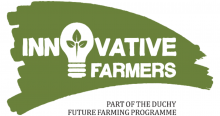Blackgrass is a native annual grass weed that occurs throughout the UK, but is most widespread in cereals in southern and Eastern England. It is most common in winter cereal crops.
Current methods to control blackgrass rely on late drilling after herbicide application, and breaks from arable production through leys, or spring sowing after a cover crop. Chemicals are being found to be increasingly ineffective due to plant resistance, and they have damaging consequences on the wider ecosystem. The management of blackgrass through fallow/grass ley breaks can cause BG seed decline in soil by about 75% per year. Fallow years and leys are not always economical for farmers who need to make a living from arable production year on year.
In this field lab Innovative Farmers are working with ADAS to understand methods of managing BG growth and inhibition in spring and winter sown crops. These trials will mimic the activities of a ley (undersowing and improving the fungal bacterial ratio) while still growing a crop.
There will be two main trials, co-designed by the farmers and the ADAS researchers:
1.) polycropping and inoculants
2.) hoe and undersown cover crops at different seed densities.
Trial 1 – polycropping and inoculants
Objective 1: Does seed inoculant or adding in crops have any effect on black-grass populations compared to a standard wheat crop in the current crop and in future seasons
Objective 2: Do mineral fertilisers affect weed growth and/or yield
Objective 3: What are the impacts on yield
The trial aims to compare BG suppression in a spring wheat monoculture compared to in poly crops or the use of an inoculant using the following treatments:
· Standard wheat crop
· Wheat and beans
· Wheat, beans undersown with clover
· Wheat treated with inoculant to increase the fungal;bacteria ratio
The seed/soil inoculant will be used to determine if it has an effect on BG populations by changing the state of the soil through biological means to improve the fungal/bacterial ratio. The use of undersown cover crops at different seed densities will be used to determine the suppression of BG populations both in the current crop and in the following crop.
It is hypothesised that a combination of these methods will have an impact on the ability of BG to thrive. Different combinations of these methods will be employed in the trial, thus providing a helpful knowledge base and quantitative data for farmers looking for non-chemical methods to control BG in a regenerative system.
Trial 2 – hoe versus undersown cover crops at different densities
Objective
Does the integration of a cover crop, at different seed densities, affect the blackgrass population when compared to inter row hoeing in wide row cropped winter wheat. We will assess BG population in the current crop and in the following crop to determine longer terms trends.
On a separate field of winter wheat we will compare the use of inter row hoeing to integrating undersown cover crops, post hoeing, at different seed densities. We will compare the BG populations:
· prior to the sowing of the cover crop
· June/early July
· in the following crop.



